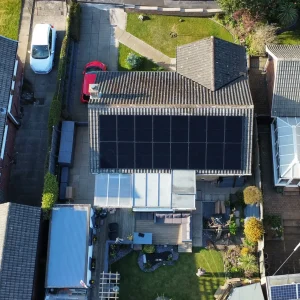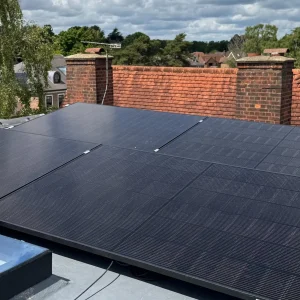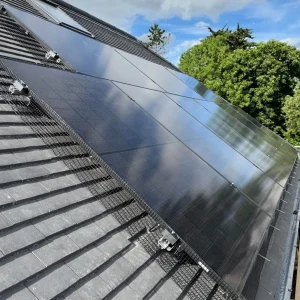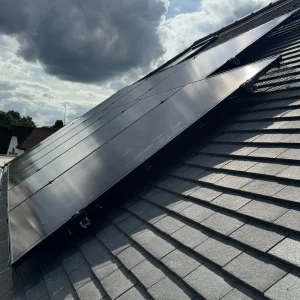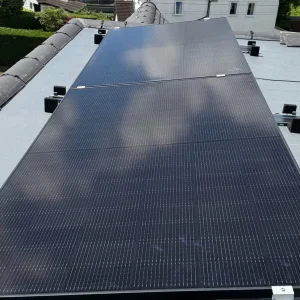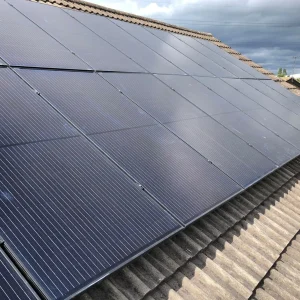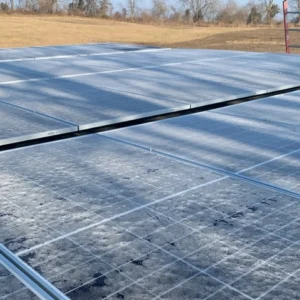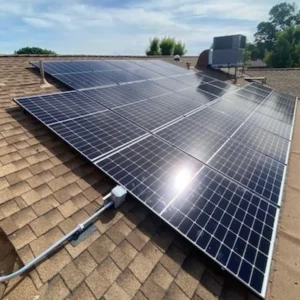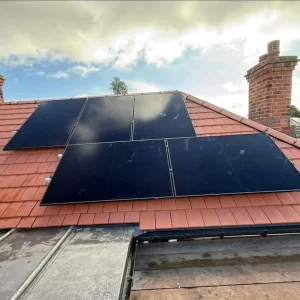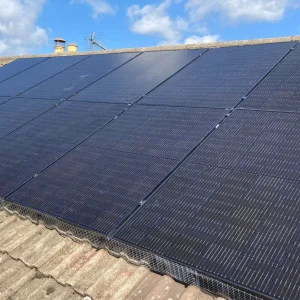Solar Panel Cleaning in Alamein will boost performance, save you money and keep your system running safely all year round.
The first thing you notice on a sunny morning in Alamein isn’t the light — it’s how your solar panels catch it, turning quiet rooftops into small power stations. But even the best panels can’t work their magic through a layer of grime.
Reviews
The Price You Pay for Neglect
Every layer of grime that builds up on a panel’s glass surface stops sunlight from reaching the photovoltaic (PV) cells underneath. In Alamein, where the rainfall is moderate and tree coverage is high, airborne dust, bird droppings and leaf litter are the main culprits.
Dirty Panels Cost You Money
According to the Clean Energy Council, a typical residential Solar PV array can lose up to 25% of its solar capacity if the panels are covered in even a light film of dust or pollution. In some suburban tests, shading from dried bird droppings caused power losses of more than 50% on affected cells.
| Condition | Estimated Efficiency Loss | Typical Causes |
|---|---|---|
| Light dust | 5–10% | Road dust, pollen, bushfire residue |
| Moderate grime | 10–25% | Rain spots, leaf debris, soot |
| Heavy build-up | 25–35% | Bird droppings, moss, and pollution |
| Partial shading | 40–50%+ | Droppings, branches, nesting birds |
Over time, dirty panels also heat unevenly, which can damage solar cells and shorten the life of your system. Many homeowners call us after noticing their inverter reports “underperformance” or “low yield” warnings — almost always linked to surface contamination.
Alamein’s Local Conditions
Alamein sits in a unique microclimate. Wind-blown dust from the Gardiners Creek corridor, fine urban soot and that sticky yellow pollen that coats cars in spring all add up to one simple fact — solar panels here get dirty faster than you think. Add that to Melbourne’s weather cycle of rain followed by heat, and you have the perfect recipe for baked-on residue.
So keeping your panels clean isn’t just about vanity — it’s about protecting your investment and maintaining solar capacity throughout the year.
DIY Solar Cleaning
Many homeowners assume a quick hose down will do the job. I get it — I used to think the same before I started working with PV arrays professionally. But solar panels are delicate instruments, and there’s a reason professional solar cleaning services exist.
Risks Of The DIY Approach
Using the wrong tools or water type can cause permanent damage. Tap water often leaves mineral deposits that scatter sunlight, and hard brushes can scratch the anti-reflective coating. Standing on a roof without the right safety gear is another big risk — not just to you but to your panels.
Common DIY mistakes we see:
- Cleaning panels in full sun causes thermal shock and cracking.
- Using detergents that leave residue.
- Rubbing dry dust into the surface, scratching the glass.
- Leaning ladders against the frames, bending the mountings.
One Alamein homeowner I met had cleaned his own panels with a garden broom and ended up reducing solar energy production by 15%. The scratches were microscopic but enough to scatter light across the whole array.
Safety On The Roof
Solar panels are often installed on sloped or high roofs, where safety should never be taken lightly. As someone who’s spent more than a decade working at height, I can tell you that experience, safety gear and proper access equipment are non-negotiable.
Common Risks Homeowners Overlook
- Slippery surfaces: Even light morning dew makes roof tiles slippery.
- Live circuits: Panels connect to live circuits; touching connectors or cables can be dangerous.
- Framed mounts: Standing on a frame can cause cracks that are invisible from the ground.
- Ladder falls: The number one cause of DIY cleaning injuries in Australia.
We use roof anchors, safety harnesses and EWP (Elevated Work Platforms) when required. Every Water Crew team member has a White Card and Working at Heights accreditation.
And yes, we’re fully insured for public liability and property damage. That’s worth the callout alone.
Professional Cleaning
There’s an art to efficient solar cleaning — it’s about getting a spotless finish without wasting water or surface wear. At Water Crew, our process combines eco-friendly methods with industry-approved safety systems.
Step-By-Step Process
- Visual inspection: We check for cracks, corrosion or nesting activity before we start.
- Purified water prep: Our mobile filtration system removes minerals and contaminants.
- Soft-brush agitation: A rotating brush head gently dislodges dirt and moss.
- Rinse and dry: We rinse thoroughly with low-pressure purified water.
- Performance check: If requested, we’ll measure before-and-after output via your inverter app or onsite readings.
We don’t use harsh detergents, power washers or abrasive pads — they might give you short-term shine but will void your manufacturer’s warranty.
Technology That Makes A Difference
For larger commercial systems in Alamein, we sometimes use robotic cleaning units or aerial thermal inspections to detect “hot spots” — areas where dirt or electrical faults reduce performance. Understanding shadow length and panel tilt helps us schedule cleaning for maximum seasonal solar performance.
Our monitoring partners factor in solar declination (the seasonal change in sun angle) to predict when panels will need the most attention — usually late autumn and early spring in Melbourne.
It’s the same level of detail that got us 100 regular clients in the first six months of business — and we’ve grown since then through word-of-mouth trust.
How Often Is Cleaning Really Needed?
There’s no one-size-fits-all answer, but in the local climate, we recommend cleaning solar panels in Melbourne every six to twelve months, depending on your location and level of exposure.
Factors That Affect Cleaning Frequency
- Trees nearby: Sap, leaves, and bird poo accelerate build-up.
- Nearby roads or construction: Dust settles faster in urban areas.
- Rainfall: Gentle rain won’t remove grime; in fact, it can make streaks worse.
- Panel tilt: Steeper angles help debris slide off naturally.
- Shadow length: Longer shading periods in winter reduce the self-cleaning effect. For Alamein residents, twice a year — late spring and mid-autumn — is usually enough. Commercial sites or flat roof installations may need quarterly cleaning.
And if you ever move to a desert — like regional Victoria or northern WA, you’ll need to clean far more often. Dust storms and long dry periods will reduce solar output faster than anything else.
Signs Your Panels Need Attention
- Power drop in your inverter readings.
- Dust is visible from the ground even after rain.
- Hot-spot warnings on your monitoring app.
- Increased electricity bills despite steady sunlight.
If you’re unsure, at Window Cleaning Melburne Crew we offer solar system health checks that include output testing, visual inspections, and photo reports — a simple way to confirm whether dirt is costing you money.
Why Choose Us

Your satisfaction is our top priority. We tailor our services to meet your specific needs

We are committed to environmental responsibility. Our cleaning products are eco-friendly.

Pricing
We offer competitive pricing without compromising on the quality of our services.

Expertise
As a locally owned and operated company, we understand the unique needs of our community.
FAQ
How do I know if my solar panels need cleaning?
Check your inverter output — a sudden drop in power during clear weather is often a sign of build-up. Visual checks after rain can also show streaks or dirt patches.
Can I use normal tap water to wash my panels?
No. Tap water has minerals that leave marks. Professionals use purified or deionised water to prevent streaking and residue.
Is cleaning covered under my solar warranty?
Most manufacturers recommend regular cleaning, but don’t include it in warranties. Not maintaining your panels can void performance guarantees.
Are chemical cleaners safe for solar panels?
No. Chemicals can strip protective coatings or interfere with light absorption. Stick to pure water and soft-brush systems.
How long does a professional solar clean take?
Most residential jobs in Alamein take about 60–90 minutes, depending on access and system size. Commercial sites can take several hours.
Explore solar panel cleaning in surrounding suburbs:

